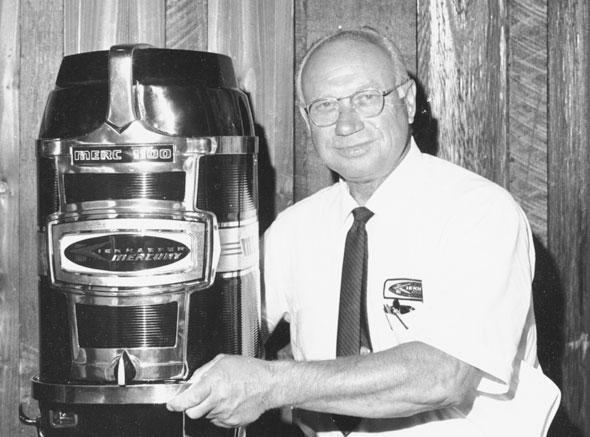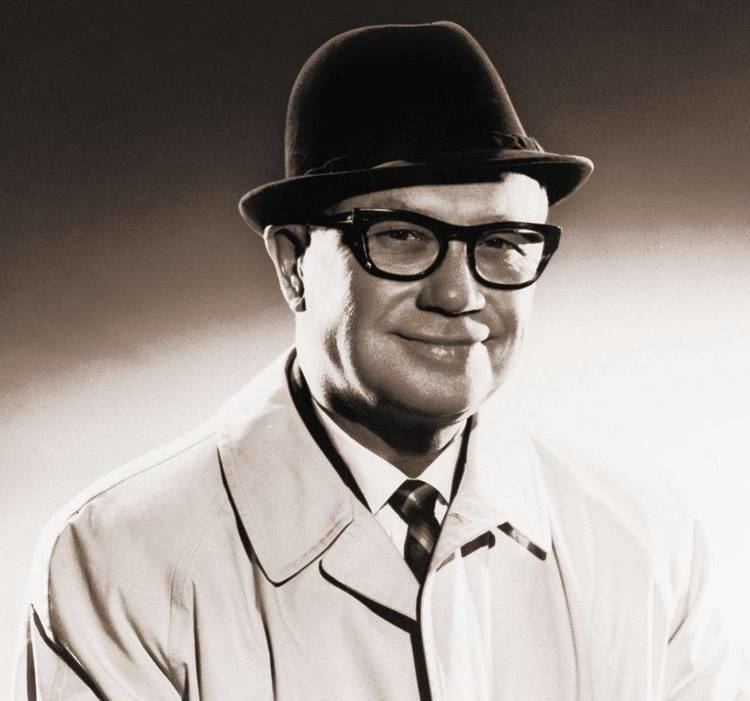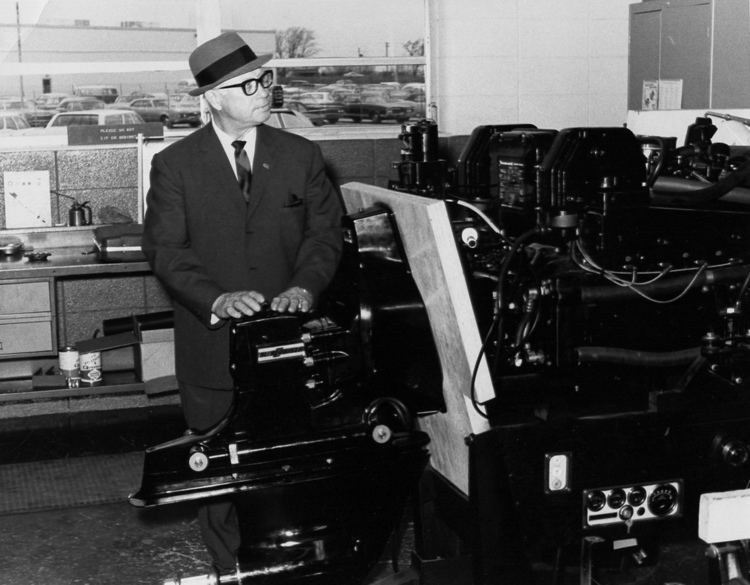Owner(s) Carl Kiekhaefer Name Carl Kiekhaefer Died October 5, 1983 | ||
 | ||
Car numbers 300, 300A, 300B, 300C, 301, 500, 500B Race drivers Buck BakerBob FlockFonty FlockTim FlockSpeedy ThompsonHerb Thomas | ||
Organizations founded Mercury Marine | ||
Elmer Carl Kiekhaefer (June 4, 1906 – October 5, 1983) was the owner of Kiekhaefer Mercury (later Mercury Marine) and Kiekhaefer Aeromarine and also a two-time NASCAR championship car owner.
Contents
- Kiekhaefer Mercury founder
- World War II
- NASCAR owner
- 1955
- 1956
- 1957
- Other highlightsinnovationsfirsts
- Road racing
- Boating pioneer
- Awards
- References
Kiekhaefer Mercury founder

Kiekhaefer (pronounced KEY-kay-fur) was born on June 4, 1906, in Mequon, Wisconsin, to Arnold and Clara Wessel Kiekhaefer. After graduating from Cedarburg High School, Kiekhaefer spent one year attending the Milwaukee School of Engineering, and later took extension courses from the University of Wisconsin that prepared him for a career in electrical engineering.

In 1927 he briefly worked as a draftsman by Evinrude Motors before being fired for "...frequent, disquieting and brazenly insubordinate arguments concerning design and product development...".

He was a young engineer right out of college when he received his first of his over 200 patents. He purchased an outboard motor manufacturing company in Cedarburg, Wisconsin in 1939, intending to make magnetic separators for the area's dairy industry. The company had 300 defective motors, which he rebuilt and sold to catalog company Montgomery Ward. Orders kept coming for the motors, and Kiekhaefer Corporation was born.
World War II

During World War II the Kiekhaefer corporation manufactured small two-cylinder "Drone Motors" that were used for target Aircraft. Since there were no computer simulators during World War Two, actual small aircraft were used as target practice to teach Anti-Aircraft gunners how to shoot down planes. These small two-stroke engines were perfect for this role.
NASCAR owner

Kiekhaefer decided to use car racing to promote his now profitable boat motor company. He entered 1954 Chrysler New Yorker club coupes in the AAA Milwaukee Mile and won all three races entered. Tony Bettenhausen and Frank Mundy drove. He then purchased large and powerful Chrysler 300s to use in NASCAR for the 1955 season. Kiekhaefer was a millionaire, so he could afford the expensive cars unlike the other teams. He bought the best equipment, and had a team, as well as transporters, unheard of in NASCAR at the time.
He brought his car with no driver to the first race at the Daytona Beach Road Course. Former champion Tim Flock had retired after the 1954 season, but was convinced to return by Kiekhaefer for $40,000.
1955
Tim Flock was the number one driver, entering 38 events, with 18 wins, 18 poles, and 32 Top-10 finishes on his way to the NASCAR championship. Kiekhaefer and Flock had a falling out early in the 1956 season.
Kiekhaefer had six drivers race for him during the 45 event season. The drivers had a combined 22 wins, 47 Top-10s, and 23 poles in their 64 races.
1956
Buck Baker was number one driver for the team. Baker entered 44 events, with 14 wins, 12 poles, and 35 Top-10 finishes on his way to the team's second consecutive champsionship.
Speedy Thompson also drove for the team, entering 39 events, with 8 wins, 7 poles, and 28 Top-10 finishes on his way to third place in the points.
Kiekhaefer had nine drivers race for him in the 56 event season, taking first, second, third, and ninth in the final series points. The drivers combined for 30 wins, 25 poles, and 92 Top-10 finishes in their 126 races. Four drivers combined for 16 straight team wins between March 25 and June 3.
1957
Kiekhaefer quit NASCAR in January 1957 after battling Bill France, over accusations of cheating by the other competitors (though no rules infractions were found under NASCAR's close scrutiny), NASCAR changed the rules to Kiekhaefer's disadvantage, and he did not want a backlash to affect Mercury sales after fans booed the team.
However, being the ever-changing personality he was, he then purchased four 1957 Chrysler 300Cs with the intent of entering the road race segment of NASCAR which only existed in 1956 and early 1957. The first "Road America competition model" he purchased (a white 300C hardtop) was resold without modification. A red car received experimental changes, and two further cars began preparation for the June race scheduled for the Road America, Elkhart Lake, Wisconsin, near Mercury Marine's home plant in Fond du Lac. The race and the series were cancelled. The two cars, a black 300C hardtop and a special order Charcoal Gray 300C hardtop were reinstated for street use and became Carl's personal car and that of his Chief Engineer, Charles Strang, respectively.
Other highlights/innovations/firsts
Road racing
Kiekhaefer participated in the 1952 and 1953 Carrera Panamericana. In 1952 he entered Chrysler Saratogas with the hemi V8 in that light body. For 1953 the factory built Chrysler New Yorker Specials known as Pan Am models. Kiekhaefer entered four of these in the '53 race.
Boating pioneer
In 1957 Kiekhaefer introduced the Mark 75 motor, the industry's first 6-cylinder 60 hp (horsepower) outboard motor. Two Mark 75 motors set an endurance record by running for 34 days, 11 hours, 47 minutes, and 5.4 seconds nonstop and over 25,000 miles. The motors were refueled on the run, and averaged 30.3 mph (miles per hour). In 1961 Kiekhaefer Marine merged with the Brunswick Corporation. Later that year Kiekhaefer would use his NASCAR and boat engineering skills to develop the 100 hp stern drive engine now known as MerCruiser. Kiekhaefer resigned as president of the company in 1969, and the company name changed to Mercury Marine.
In 1970 he founded Kiekhaefer Aeromarine Motors, building racing engines. After Carl's death, in 1983 his son Fred secured control of the company and took it out from the engine business focusing on propulsion hardware. In 1990 Kiekhaefer Aeromarine was sold to the Brunswick Corporation.
